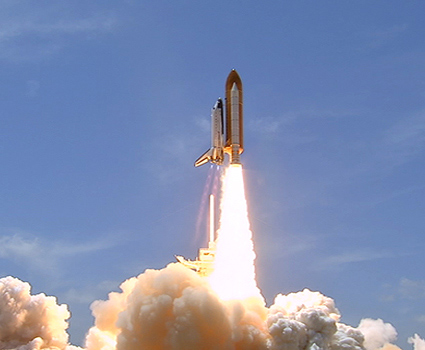Space Junk May Make Shuttle Atlantis' Arrival at Station Trickier

A piece of space junk near the International Space Station this weekend may force the massive orbiting laboratory to dodge out of the way, adding a bit more complexity to the shuttle Atlantis' planned arrival at the outpost on Sunday.
The chunk space debris is expected to zip by the station Sunday morning. To dodge it, the orbiting lab may fire its Russian thrusters Saturday at about 9:08 p.m. EDT (0108 Sunday GMT), NASA officials said.
That means NASA's space shuttle Atlantis, which blasted off from Florida Friday afternoon on what is expected to be its last-ever mission, will have to make some trajectory changes as it approaches the International Space Station. [See Atlantis' launch photos.]
"It's a little unique. With the shuttle going up to rendezvous we need to be very careful with what kind of maneuver we go do," said NASA space operations chief Bill Gerstenmaier after Atlantis' successful launch.
NASA is keeping a close watch on how far the space station would have to move in order to be sure it doesn't drift too far away from a docking lane in space that Atlantis can reach, Gerstenmaier said. The space station typically flies in an orbit about 220 miles (354 km) above Earth and circles the planet at a steady 17,500 mph (28,163 kph) to remain aloft.
Once the station performs a maneuver — an engine burn, in NASA parlance — engineers will recalculate the trajectory of the station and Atlantis, then beam new instructions to the shuttle astronauts to retarget the shuttle for its Sunday docking, Gerstenmaier said.
The station and Atlantis are scheduled to dock Sunday at 10:27 a.m. EDT (1427 GMT). Until then, eager skywatchers have a chance to see a rare sky showas Atlantis, the station, the planet Venus and the moon all appear in the night sky this weekend.
Breaking space news, the latest updates on rocket launches, skywatching events and more!
Few details about the wayward space junk, such as its size, origins or exact distance from the station at closest approach were immediately available, NASA officials said. But space debris does force the station, and other satellites, to perform dodging maneuvers from time to time.
"It is flying in a very elliptical orbit," NASA spokesperson William Jeffs told SPACE.com, from the agency's Johnson Space Center in Houston. That makes the debris difficult to track, but Mission Control is keeping a close eye on it, he added.
Space junk is a constant threat to spacecraft, astronauts and satellites in orbit. That space debris danger has grown in recent years due to a 2007 Chinese anti-satellite test and the accidental crash of satellites from the United States and Russia in 2009.
Both incidents created vast new clouds of space junk, which is being monitored by NASA and the U.S. military's Space Surveillance Network along with more than 19,000 other bits of orbital debris.
NASA typically moves the station when the risk of a space debris impact is within a 1-in-10,000 chance. Mission Control also works to keep a safety perimeter that extends 15 miles (25 km) around the space station, as well as about a half-mile (0.75 km) above and below it.
Gerstenmaier said that any maneuver performed by the space station should not have a major impact on Sunday's planned docking by Atlantis. It will just require some extra planning and analysis, he said.
Atlantis' six-astronaut crew is flying a planned 12-day mission to the International Space Station to deliver a new Russian research module called Rassvet(which means "Dawn" in Russian). The astronauts also plan to replace old solar array batteries and deliver spare parts during their flight. Three spacewalks are scheduled.
This STS-132 mission is slated to be Atlantis' 32nd and final spaceflight as NASA prepares to retire its three-shuttle fleet at the end of the year. Only two more shuttle flights — on Atlantis' sister ships Discovery and Endeavour, respectively — are scheduled after this one.
SPACE.com is providing complete coverage of Atlantis' STS-132 mission to the International Space Station with Senior Writer Clara Moskowitz and Managing Editor Tariq Malik based in New York. Click here for shuttle mission updates and a link to NASA TV.

Tariq is the award-winning Editor-in-Chief of Space.com and joined the team in 2001. He covers human spaceflight, as well as skywatching and entertainment. He became Space.com's Editor-in-Chief in 2019. Before joining Space.com, Tariq was a staff reporter for The Los Angeles Times covering education and city beats in La Habra, Fullerton and Huntington Beach. He's a recipient of the 2022 Harry Kolcum Award for excellence in space reporting and the 2025 Space Pioneer Award from the National Space Society. He is an Eagle Scout and Space Camp alum with journalism degrees from the USC and NYU. You can find Tariq at Space.com and as the co-host to the This Week In Space podcast on the TWiT network. To see his latest project, you can follow Tariq on Twitter @tariqjmalik.
